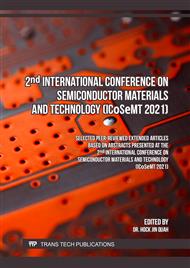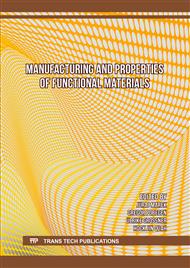[1]
S. Gupta and N.H. Tai, "Carbon materials and their composites for electromagnetic interference shielding effectiveness in X-band," Carbon N. Y., vol. 152, p.159–187, 2019.
DOI: 10.1016/j.carbon.2019.06.002
Google Scholar
[2]
D.L. Zhao, X. Li, and Z.M. Shen, "Microwave absorbing property and complex permittivity and permeability of epoxy composites containing Ni-coated and Ag filled carbon nanotubes," Compos. Sci. Technol., vol. 68, no. 14, p.2902–2908, 2008.
DOI: 10.1016/j.compscitech.2007.10.006
Google Scholar
[3]
P. Banerjee, Y. Bhattacharjee, and S. Bose, "Lightweight Epoxy-Based Composites for EMI Shielding Applications," J. Electron. Mater., vol. 49, no. 3, p.1702–1720, 2020.
DOI: 10.1007/s11664-019-07687-5
Google Scholar
[4]
BR. Kim, H.K. Lee, S.H. Park, and H.K. Kim, "Electromagnetic interference shielding characteristics and shielding effectiveness of polyaniline-coated films," p.3492–3496, 2011.
DOI: 10.1016/j.tsf.2011.01.093
Google Scholar
[5]
Y. Chen, Y. Li, M. Yip, and N. Tai, "Electromagnetic interference shielding efficiency of polyaniline composites filled with graphene decorated with metallic nanoparticles," p.80–86, 2013.
DOI: 10.1016/j.compscitech.2013.02.024
Google Scholar
[6]
B.V. Basheer, J. J. George, S. Siengchin, and J. Parameswaranpillai, "Polymer grafted carbon nanotubes-Synthesis, properties, and applications: A review," p.100429, 2020.
DOI: 10.1016/j.nanoso.2020.100429
Google Scholar
[7]
B.Suresha, N.M. Indushekhara, C.A. Varun, D.Sachin, and K.Pranao,"Effect of carbon nanotubes reinforcement on mechanical properties of aramid/epoxy hybrid composites," pp.1478-1484, 2020.
DOI: 10.1016/j.matpr.2020.09.307
Google Scholar
[8]
S.Tiwari, K.Srivastava, G.CL, and D.Srivastava,"Epoxy/Fly ash from Thermal Power Plant/ Nanofiller Nanocomposite:Studies on Mechanical and Thermal Properties: A Review," pp.1-16, 2020.
DOI: 10.35248/2252-5211.20.10.375
Google Scholar
[9]
N. Anzar, R. Hasan, M. Tyagi, N. Yadav, and J. Narang, "Carbon nanotube - A review on Synthesis, Properties and plethora of applications in the field of biomedical science," p.100003, 2020.
DOI: 10.1016/j.sintl.2020.100003
Google Scholar
[10]
Y. Yusof, Z. Y. Ng, Y. H. Wong, and M. R. Johan, "The tunable permittivity of multi-walled carbon nanotubes/silver nanoparticles reinforced polyvinyl alcohol (PVA) nanocomposites at low frequency," Mater. Res. Express, vol. 5, no. 8, 2018.
DOI: 10.1088/2053-1591/aad442
Google Scholar
[11]
K. K. Agarwal and G. Agarwal, "A study of mechanical properties of epoxy resin in presence of different hardeners," Technol. Innov. Mech. Eng., no. June, 2019.
Google Scholar
[12]
A. E. Krauklis and A. T. Echtermeyer, "Mechanism of yellowing: Carbonyl formation during hygrothermal aging in a common amine epoxy," Polymers (Basel)., vol. 10, no. 9, 2018.
DOI: 10.3390/polym10091017
Google Scholar
[13]
M. Ghaemy and M. H. Riahi, "Property-Structure relationships in epoxy resin systems," p.119–126, 1996.
Google Scholar
[14]
S. Bibi, A. Jamil, T. Yasin, M. A. Rafiq, M. Nawaz, and G. J. Price, "Ultrasound promoted synthesis and properties of chitosan nanocomposites containing carbon nanotubes and silver nanoparticles," p.297–303, 2018.
DOI: 10.1016/j.eurpolymj.2018.06.004
Google Scholar
[15]
O. Pryshchepa, P. Pomastowski, and B. Buszewski, "Silver nanoparticles: Synthesis, investigation techniques, and properties," Adv. Colloid Interface Sci., vol. 284, p.87–100, 2020.
DOI: 10.1016/j.cis.2020.102246
Google Scholar
[16]
J. Zhang et al., "Homogeneous silver nanoparticles decorated 3D carbon nanotube sponges as flexible high-performance electromagnetic shielding composite materials," p.404–411, 2020.
DOI: 10.1016/j.carbon.2020.04.043
Google Scholar
[17]
S.M. Al-ghannam, "Enhanced Dielectric Properties of Polyaniline /Silver /Carbon Nanotubes," vol. 4, no. 1, p.16–22, 2014.
Google Scholar
[18]
Zhou, M., Lu, F., Chen, B., Zhu, X., Shen, X., Xia, W., ... & Zeng, X. (2015). Thickness dependent complex permittivity and microwave absorption of NiCo2O4 nanoflakes. Materials Letters, 159, 498-501.
DOI: 10.1016/j.matlet.2015.08.053
Google Scholar



